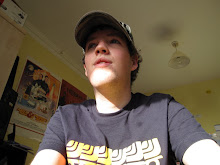While I have been shooting photographs, I haven't really had much time to check out the work of other night time photographers so i just wanted to add this blog entry as a bit of a quick glance at how some other photographers have presented the night in their photographs.
The first photographer I want to look at is Chrystel Lebas who is well known for her photographic work of the night:
She has her own website which i decided to visit called www.chrystellebas.com
The website itself simply consists of PDF format 'portfolios' which include work from different shows and events she has displayed work for; for my interests, I decided to open the project called: Timeinspace, which appeared to feature work of relevance to my study.
She added these quotes and details to her PDF presentation on her website:
For the Greeks, Night (Nyx) was the daughter of Chaos and the mother of Sky (Ouranos) and Earth (Gaia) [...] She also engendered sleep and death, dreams and anguish, tenderness and deceit. Novalis, in his Hymn to the Night, celebrates Night, symbolised by sleep and dream, as a triumph over time: Aside I turn to the holy, unspeakable, mysterious Night More heavenly than those glittering stars we hold the eternal Eyes, which the Night hath opened within us. Farther they see than the palest of those countless hosts... Needing no aid from the light, they penetrate the depths of a loving soul that fills a loftier region with bliss ineffable.
Some amazing depth is given to the meaning of the sky at night by these extracts. I do find it amazing how people are equally passionate about the sky like I am which gives me additional motivation to go and shoot some beautiful photographs for all to see.
Here is another extract from her PDF portfolio:
Each series offers various types of travel to the viewer. Travel through space in search of a specific location; travel of the mind through sleep; time-travel involving a set period of time from point A to point B: from nightfall to daybreak, or from the start of a journey to the final destination. Taken from a rooftop in the middle of the city (London), this series evokes contemplation of the night and the intimate relationship between interior and exterior spaces. The roofs form an island which allows the viewer to distance himself from the scene, and to observe the untouchable city. Long exposures taken with a large-format camera record traces of the movement of the moon, stars and aeroplanes, giving to this nocturnal space a sense of human appropriation of the sky and landscape. Exposures of 30 minutes, during which time I had to stay next to the camera, gave me the opportunity to contemplate this dark city and the intimacy of its windows of light. In the dark, nearly black foreground of these photographs, the viewer can discover a few human traces: washing-lines and gardens.
Chrystel Lebas
Her photos are given a great deal of depth by the way in which she talks about them, as above, she talks about the rooftops of London, providing a viewpoint into a city which cannot be touched by himself. This idea is very true, as the viewer can clearly see the area and go into the city, but simply cannot interact with it or really touch it, so it is very much a separate existing object.
Lebas has also done a few photographs which feature the blue or 'Azure' that is the night sky, whereas she has shot her photographs on film for between 2-6 hours, in some cases seeing the light disappear and then reappear at dawn!
Here is an example of her work showing the movement of the Moon through the shot:

Image sourced from PDF Portfolio @: www.chrystellebas.com
Just before these images depicting the Azure, Lebas makes reference to 'the passage of time' in the portfolio, as in this extract:
The panoramic camera is used here for technical reasons. The lens rotating on an axis turns upon itself, its continuous movement across the area to be photographed records the landscape in the form of multiple exposures. The long exposure times, from 2 to 6 hours, illustrate the passage of time, moving from day to night to day again. The 146-degrees rotating-lens, the arc travelled by the lens rotation, is close in its range to the field of vision of the human eye. Seen in an exhibition context and enlarged (2m. long), these images give the viewer the feeling of being absorbed by the colour surface where shapes appear slowly from the shadows.
She uses a panoramic camera to allow her to capture a fully wide angle photograph while the extensive exposure time allows the viewer to experience the passage of time, she also discusses how she prints the photographs up to 2 metres long which would be appropriate for my photographs although I am simply not sure my digital files would allow this. It may be worthwhile looking into an analog option if this is the case.
Lebas' work is very thoughtful and packed full of meaning, although the images themselves show very little, they do inspire the viewer to think about the landscape in which they live, after looking at the bibliography at the back of the portfolio, I realised that some of the photos were taken in neighbouring Cornwall, which surprised me as I simply couldn't tell from the image alone.
With my own images I want to inspire thought in the viewer, make them think about their surroundings and what they miss out on while they sleep and I shoot photographs, this interest will extend until I get a truly amazing photograph much like some of the previous photographs I have seen, mostly taken in America. I want to shoot one which features part of my local landscape.

No comments:
Post a Comment